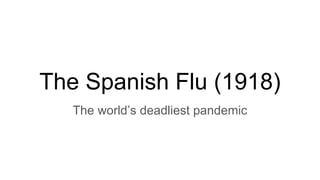
The Spanish flu
- 1. The Spanish Flu (1918) The world’s deadliest pandemic
- 2. How deadly was the Spanish Flu? Through 1918-1919, the Spanish flu killed an approximate 20-50 million people worldwide, making this the world’s deadliest pandemic so far. Some estimates even go upto 100 million. It killed 12-17 million people in India alone (5% of its population). It spread throughout the world, killing hundreds of thousands of people in several countries. In fact, it killed way more people than World War I that directly preceded the Spanish Flu.
- 3. In America, 28% of the population were infected and close to 675,000 people died. Around the globe, the flu affected 500 million people which was 25% of the then world’s population.
- 4. Why was it called Spanish Flu? Strangely enough, the Spanish Flu didn’t even originate in Spain. We are still not sure where it started. It could have been in China, Britain, France or even America, but it was certainly not in Spain. The reason for the name was because Spain was neutral in World War, and its media freely reported news about the subsequent flu that was ravaging the world. The media in other countries were strictly censored to maintain its public’s morale. So everyone thought this scourge was only limited to Spain. The name stuck.
- 5. Where did the Spanish flu originate? Scientists are still not sure about how the Spanish flu originated. There are currently three theories about its origin. The virus may have originated in China, and travelled to Europe via thousands of Chinese laborers who were being transported to the war front in Europe. There is evidence that there was a respiratory illness which broke out in November 1917 in China, which was identical to the Spanish flu.
- 6. British troops in France : The crowded and cramped staging hospital in Estaples (France) treating thousands of soldiers of the World War is seen as a possible starting point. The camp also had a piggery, and it is theorised that the virus originated in birds and then mutated rapidly to infect pigs and thence the humans in the camp. The virus may have originated in Fort Riley, Kansas (USA), which also stocked poultry and swine. There are reports of an early outbreak in March 1918 in this location. Upon the deployment of American soldiers to Europe, the virus then spread widely across the globe.
- 7. The truth is we are still not sure where the virus originated, and the above theories are the most plausible at this time. But what is certain is that the world war contributed greatly in the global spread of the virus, with soldiers traveling to and from the war front and back to their home countries.
- 8. Symptoms of the Spanish flu The milder symptoms typically included flu-like conditions like cough, fever, bodyache, fatigue etc. The more serious symptoms were severe pneumonia, skin turning blue, lung congestion with lots of fluid, respiratory failure, all of which typically lead to death in a few days (even hours in some cases).
- 9. Why was this flu so deadly? Typically, influenza affects older people, young children and people with pre- existing conditions disproportionately, because of their relatively weaker immune systems. In fact the first wave of the Spanish Flu was just that. It killed people with compromised immune systems and others easily recovered. But in the fall of 1918, the second wave started with the virus mutating into a deadlier form. This was more devastating for the 20-40 age group. This virus unleashed a cytokine storm in the body (overreaction of the immune system) of young adults. People were dead within days (sometimes hours) of contracting the virus. October of 1918 was the deadliest month of the whole pandemic.
- 10. Some theorize this was because of a reversal of conditions from a normal civilian pandemic. During the War, mildly affected soldiers stayed put and fought. The severely affected ones were sent to crowded hospitals where they spread the nastier version of the virus throughout the civilian population. Also, there was no vaccine or antiviral drugs that existed then, to treat the problem. The only defence was the body’s own antibodies to somehow overcome the virus, which was just not enough. Flu vaccines came into being only in the 1940s. Another theory floating around is the over-prescription of aspirin to patients. Bayer’s patent of aspirin had just ended in 1917, and several companies rushed to produce and sell aspirin, and thus there was a vast supply in the market. Super high doses were prescribed by doctors, levels which are now known to be toxic.
- 11. What did people do to combat the Spanish flu? Since there was no vaccine or even proper drugs to combat this menace, people did the following, which are extremely relevant even today: ● Social distancing methods ● Isolation of the infected ● Shutting down schools, movie theatres, congregations and public places ● Lots of protective equipment (like face masks) for health workers, and to the general public ● “Open air” treatment - patients were housed in temporary hospitals with lots of fresh air, ventilation, sunlight and nutritious food ● Lots of emphasis on hygienic surroundings and cleanliness
- 12. How did the Spanish flu end? The pandemic ended by itself around the summer of 1919. Basically, people who got infected either became immune to the virus, or died. One theory is that the virus also mutated to a less murderous version. This also makes sense from the point of view of the virus. If the virus is so deadly that it simply kills its host, then it will quickly run out of people to infect. By becoming more “benign” it increases its chances of survival.
- 13. The three waves of the Spanish flu